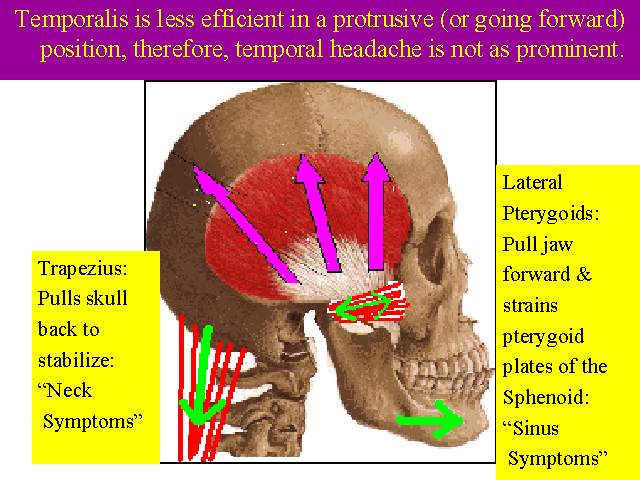Chapter 8
(see also Migraine Mix-up)Well, now that we've talked about the lateral pterygoid, I might as well give you the rest of its story. Some might think this is complicated stuff, but I hope to make it as simple as it really is. Ready? Remember, we said that one end of the lateral pterygoid attaches to the top end of the jawbone. The other end attaches to the walls of the nasal passages. I've mentioned earlier that the lateral pterygoid moves your jaw from side to side. Actually, you have two lateral pterygoids: a right one, and a SOLVING THE SINUSES
left one. The lateral pterygoid on the right pulls your jaw to the left, and the one on the left pulls your jaw to the right. How's that again? Remember, all a muscle can do is contract, that is, get shorter. One end of a muscle is attached at a stable bone, called the origin. The other end is attached on the bone to be moved, called the insertion. The right lateral pterygoid, for example, is anchored deep behind your nose and above your upper molars, on a potato chip thin plate of bone. It then extends backward and outward, attaching to the top end of your jawbone (the condyle), right in front of your ear canal. So when the lateral pterygoid contracts, it pulls the condyle forward. Since the jaw is like a horseshoe (and if the left lateral pterygoid isn't doing anything), the net effect of a contraction of the right lateral is that your entire jaw shifts to the left. If both lateral pterygoids are contracting, the entire jaw is pulled forward and/or opened. When you can't seem to open your mouth without your jaw shifting to one side or the other, it is usually because one of the lateral pterygoids is highly fatigued, and can't coordinate well with the other.When your temporalis closes your mouth enough so that your teeth can touch, and then you move your jaw over to the left a bit and hold it there, you'd be using the right lateral pterygoid to do so. Essentially, you'd be clenching your teeth on the left side. If you were to hold that position long enough, guess what? The right lateral pterygoid becomes dysfunctional. Where, then would it hurt? At one or both ends of the muscle, where it attaches at the jaw joint (the condyle), or at the other end, along the nasal passages. Frequently, when a lateral pterygoid muscle becomes dysfunctional, it will cause pressure and pain in and around the nasal passages and sinuses, and can be called a sinus headache. Not only does the patient feel pain and pressure from the sinuses, but also a dysfunctional lateral pterygoid will cause the sinuses to produce a discharge (a runny or stuffy nose). This patient is in a real fix. A visit to the sinus specialist for a special x-ray reveals nothing particularly wrong with their sinuses. Antibiotic therapy rarely resolves the condition. The patient is convinced, however, that there is definitely a problem with the sinuses. The patient maintains this conviction by observing that they do get some relief from sinus headache medications. What's in sinus headache remedies? High dosages of analgesic (pain medication) for muscle pain and decongestants for a stuffy, runny nose... the two symptoms that result from a dysfunctional lateral pterygoid!

In order for a lateral pterygoid to become dysfunctional, it needs resistance for it to contract against. The resistance is provided by the temporalis' efforts of pressing the teeth together (making it difficult to move the jaw sideways). So by suppressing temporalis intensity, the NTI-tss also inhibits the intense activity of the lateral pterygoid muscles, thereby relieving sinus symtoms and jaw joint strain.